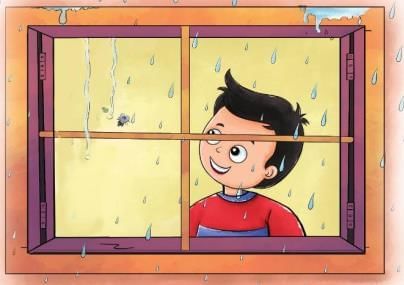Summary: Waiting at the Window | English Class 3 ICSE PDF Download
| Table of contents |

|
| Introduction |

|
| Key Points of the Poem |

|
| Summary |

|
| Message |

|
Introduction
"Waiting at the Window" is a fun poem by A.A. Milne. It tells the story of a child who watches two raindrops race down a window. The child names them John and James and cheers for one to win. The poem is simple and shows how a child finds joy in a small, everyday moment.

Key Points of the Poem
- The poem is about a child who watches raindrops on a window.
- The child names the raindrops John and James and watches their race.
- The poem shows how the child enjoys the race and feels happy when the sun comes out.
Summary
Stanza 1
These are my two drops of rain
Waiting on the windowpane.
I am waiting here to see
Which the winning one will be.
In this stanza, the child sees two raindrops on the window. The child waits to see which one will win the race.

Stanza 2
Both of them have different names.
One is John and one is James.
All the best and all the worst
Comes from which of them is first.
In this stanza, the child gives the raindrops names, John and James. The child thinks about what will happen based on which one reaches first.
Stanza 3
James has just begun to ooze.
He's the one I want to lose.
John is waiting to begin.
He's the one I want to win.
In this stanza, the child notices that James starts moving slowly, which the child doesn’t like. John is still waiting to start, and the child wants him to win.
Stanza 4
James is going slowly on.
Something sort of sticks to John.
John is moving off at last.
James is going pretty fast.
In this stanza, the child sees James moves slowly while something sticks to John. Then John starts moving, and James goes faster.
Stanza 5
John is rushing down the pane.
James is going slow again.
James has met a sort of smear
John is getting very near.
In this stanza, the child watches John rushes down quickly, but James slows down again. James meets a dirty mark, and John gets closer.
Stanza 6
Is he going fast enough?
(James has found a piece of fluff.)
John has quickly hurried by.
(James was talking to a fly.)
John is there, and John has won!
Look! I told you! Here's the sun!
In this stanza, the child wonders if John is fast enough. James gets stuck with some fluff and talks to a fly. John wins the race, and the sun comes out.
Message
The poem teaches us to find joy in simple things like watching raindrops and to stay happy even on rainy days.
New Words with Meanings
- Ooze: To move or come out slowly.
- Smear: A dirty or oily mark.
|
36 docs|18 tests
|
FAQs on Summary: Waiting at the Window - English Class 3 ICSE
| 1. What is the main theme of the poem "Waiting at the Window"? |  |
| 2. Who is the poet of "Waiting at the Window," and what is his significance in literature? |  |
| 3. How does the imagery in "Waiting at the Window" enhance the poem's message? |  |
| 4. What emotions does the child express while waiting at the window in the poem? |  |
| 5. How does "Waiting at the Window" reflect the experiences of childhood? |  |














